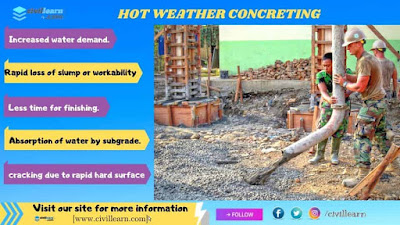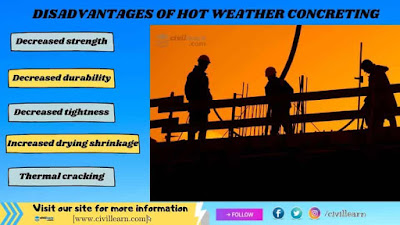What is Hot weather concreting
Concrete must need to be prepared mixed, transported, placed, compacted, cured, and protected taking into consideration the ambient temperatures. Construction practices must need to be varied from traditional practices, depending on the climatic conditions.
The normal procedure adopted for concreting in fair weather will not be valid for concreting under special conditions. The performance of concrete is adversely affected unless appropriate measures are taken to control it. The concreting under special conditions include the following given below.
- Cold Weather concerning
- Hot Weather Concreting
- Under Water Concreting.
Any concrete operation performed at a temperature above 40°C is called hot weather concreting. Indian standard codes recommend that proper precautions should be taken if the concrete is to be placed at a temperature above 40°C. The effects of hot weather on concrete are summarized given below the following points.
- Increased water demand.
- Rapid loss of slump or workability of concrete.
- The rapid rate of hydration of cement, quick setting, and early stiffening.
- Absorption of water by subgrade.
- Rapid setting and hardening of concrete.
- Increased possibility of plastic cracking due to rapid surface drying conditions.
- Critical need for early curing.
- Increase in plastic shrinkage when high temperatures are accompanied by ni are accompanied by high-velocity winds.
- Less time for finishing.
Adding water at the job site is not advisable as it can adversely affect ma properties in the fresh and hardened concrete and reduces the following main major defects given below.
- Decreased strength - Due to high temperature, the rate of hydration reaction increases, this leads to greater early strength, but the long-term strength of the concrete also gets reduced strength due to high temperature. This happens due to loss of moisture and a decrease in workability which also affects compaction.
- Decreased durability - As discussed above, the workability of concrete is reduced by hot weather, and to make up for the same, more amount of water is added, which leads to the generation of pores inside the concrete as moisture gets dried up quickly. This makes the concrete porous and its durability is impacted.
- Decreased tightness (permeability) - Due to high temperature, the rate of hydration reaction increases, and the water is evaporated quickly and the compaction of concrete is not done properly due to loss compaction hence the resultant decreased tightness.
- Increased drying shrinkage - The rate of evaporation increases with increasing temperature and wind speed and decreasing relative humidity. When freshly placed concrete bleeds, i.e the movement of water from the inner surface of the concrete member, this moisture gets dried up quicker than the speed with which it is replaced by bleeding action. This leads to the development of plastic shrinkage cracks on the concrete surfaces.
- Increased tendency of differential thermal cracking - The rate of evaporation increases due to increasing temperature and wind speed and decreasing relative humidity. When freshly placed concrete in hot weather they bleed, i.e the movement of water from the inner surface of the concrete member, this moisture gets dried up quicker than the speed with which it is replaced by bleeding action. This leads to the development of plastic shrinkage cracks on the concrete surfaces.
In order to avoid the above situations, the concrete mix must be designed considering the ambient conditions in the field.
Precautions before Hot weather concreting are the following given below.
- Concreting should be started after consultation with the weather forecast department. High temperatures are generally accompanied by high-velocity winds and lower relative humidity may disturb the properties of concrete in the plastic and hardened stage.
- To improve the quality of concrete it is necessary that the temperature of concrete should be as low as possible.
- Source of water must be of permanent nature so that sprinkling may be done frequently on aggregates, wooden formwork, the prepared sub-base.
- Temporary sun shades and wind barriers may be erected with the help of tarpaulins.
- Concrete operations must be avoided in the afternoons but can be restricted, to evening or night hours.
- All the necessary equipment like batching plants, mixers, hoppers, etc. should be shaded or painted white or covered with jute cloth.
- The water must be sprinkled over formwork, reinforcement steel, and the prepared surface.
Precautions during and after Hot weather concreting are the following given below.
- The prepared concrete should be immediately transported and placed so that the loss of moisture from concrete can be minimized.
- Reinforcement, formwork, and subgrade should be sprinkled with cooled water just prior to placing concrete.
- Compaction and finishing operations must be performed immediately well before the initial setting of concrete.
- The finished concrete should be protected from direct exposure to high temperatures and high-velocity winds. The freshly laid concrete must be covered with wet jute bags
- To avoid alternate wetting and drying during the curing period, the concrete surface should be kept wet constantly.
- Retarders may be used but with utmost care and under strict supervision.
- It is preferable to design concrete mixes with minimum possible cement content in the weather conditions. Concrete mix with less cement content will evolve less heat and thereby evaporation and hydration losses of water will reduce considerably.
Less cement will also reduce to some extent drying shrinkage cracks in concrete e must be taken to satisfy both strength and durability requirements.






![[3] Main method of estimation | Center line method and Long Wall-short Wall method](https://blogger.googleusercontent.com/img/b/R29vZ2xl/AVvXsEi-tUtY1W3S747Ws8mkCIvT9rCeji2iB5dIgISp1Y3SnuuLT3kcHKc6pm-eTghLLCoPSATf4L_dBVMvDCcstWv99RZc6ddp4yVoWT2mthaDW-1569tju756sMH3c3gDJZ_6iMkGcbd7c5U/w680/estimation+of+building.jpg)


0 Comments
Please do not enter any spam link in the comment box.